 Great characters of Universal Gnosticism
Great characters of Universal Gnosticism  Raphael Sanzio, serene and quiet spirit, part 1
Raphael Sanzio, serene and quiet spirit, part 1
Raphael Sanzio, serene and quiet spirit, part 1 |

|

|
| Written by Editor VOPUS | |||
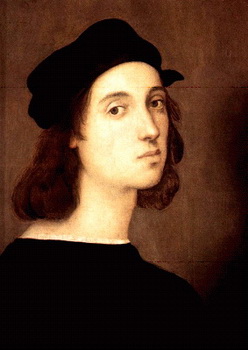
Raphael or Raffaello firstly saw the blessed light of the sun on the 6th of April 1483, in full Italian renaissance apogee, the Cinquecento era. Urbino, ‘the green heart of Italy’ is the birthplace of the artist, and his parents were Giovanni Santi and Magia di Battista Ciarla. The faith decided that he would remain orphan as a child, but he will find material and financial support in his uncle who will support him on his road towards glory. Having artistic inclinations, he becomes at the age of 11, the disciple of painter Pietro Perugino, becoming later his most brilliant student. At the beginning of the 1500s, he travels to Siena, Florence, Perugia, and Rome. Around that time Leonardo da Vinci and Michelangelo were known and appreciated for their art. For Raphael, Leonardo’s art will have a great meaning. The finesse with which he was modeling the face of the Madonnas and of the Saints impressed the young artist. The profoundness and the delicacy of the elder master’s paintings resonated with his interior nature. It is said that Raphael, serene and charming spirit, was loved by all those who knew him and the cardinals, the popes and the men of culture admired him. AHis art finds its philosophical exponent in Plato’s writings, ‘The Dialogues’ being translated by Marsilio Ficino, member of the Florence Academy, the place where the platonic philosophy was especially studied. Among other thinkers there are Giovanni Pico della Mirandola, Pietro Bembo, the academy being sustained by the powerful family of Medici. Plato said in his writings: ‘A life that is not deepened, isn’t worth living’, a lesson that Raphael tried to learn during his short existence, and through his works he also tried to transmit us the same thing. In these lines we will not try to chronologically present the master’s works, but to understand the message that he transmits through his work. 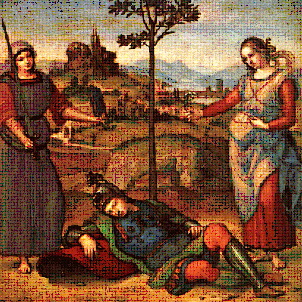
We will start this research on the road of wisdom with the painting the ‘Knight’s Dream’, made in 1505, having symmetry as compositional structure, characteristic to the renaissance. In the foreground, is the knight sleeping on a shield; the axial centre of the composition is given by the tree and the symmetry by the two feminine characters. These ones hold in their hands some symbolic objects: the woman in the right has a white flower, disposed on the same plan with the book in the hand of the character at left, the flower is the symbol of virtue, disposed in front of the book can mean: ‘through virtue you will get the wisdom’. In order to get virtues it is necessary to have will (that is to say the sword in the hand of the character at left): this way we have three important virtues in the awakening and the development of faith: wisdom, virtues, will. The philosophy of the awakening evoked by many wise people from ancient times until the times of this era is definitively not unknown to Raphael. Those who, overcome by fascination, dreams, illusions, sleep their life, those should fight for awakening and truly living. Oh, you people, conceived of earth, you who abandoned yourselves to the dark and to the sleep and to the ignorance of the God, wake up now! These are the words of the great wise man Hermes Trismegistus. So, understanding, that in these lines we don’t talk about a physical, exterior awakening, but about the awakening of the consciousness, as the contemporary gnosis transmits us through Samael Aun Weor’s words: It is necessary to know that humanity lives with the consciousness sleeping. People work dreaming. People walk on the street dreaming. People live and die dreaming. When we reach to the conclusion that the world lives asleep we understand the necessity of awakening. We need the awakening of consciousness. We want the awakening of consciousness...the cause of the profound sleep in which mankind lives is Fascination. People are fascinated by all the things of life… The fascinated human being doesn’t remember itself. We must remember ourselves every moment... 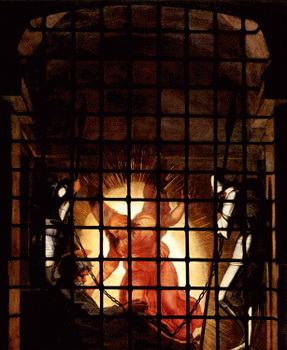
We continue with the next work: ‘The Deliverance of Saint Peter from Prison’, fresco painted between 1513-1514 in the palace of Vatican, Rome. This fragment represents the central part of the fresco and presents Saint Peter in jail, next to him being an angel who tries to help him. For Rafael, freedom was like a smooth wind blow that refreshes the air and bunts the navigator’s sails...it was indispensable. But about what kind of freedom does Raphael speak? ‘The word Freedom is fascinating, everyone likes it, however, there it doesn’t exist a true understanding of this one, there is a confusion regarding this word… how many murders were committed in its name! Without discussion the term Freedom hypnotized the crowds; the mountains and the valleys, the rivers and the seas were stained with blood under the spell of this magical word… unfortunately, after any independence obtained with such a big price, the slavery continues inside each person. Freedom is something that must be found inside us. No one can obtain it outside himself. No one could really experiment Freedom as long as consciousness continues to be corked in the self itself, in the ego itself. There is no way that we could destroy the handcuffs of slavery, without having before understood all this ‘mine’ matter, everything that regards the ego, the ego itself.’ 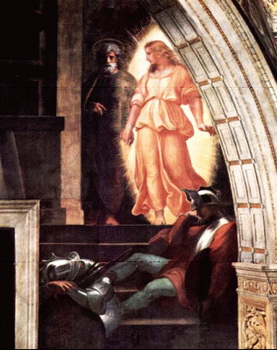
‘What does slavery consist of? What keeps us slaves? Which are the obstacles? This is what we have to discover… As long as the consciousness, the essence, what we have more dignified and more decent inside us, will continue to be corked in the self itself, in the ego itself, in my lusts and fears, in my wishes and passions, in my preoccupations and violences, in my psychological flaws, we will be for sure in a jail. The sense of Freedom can be entirely understood only when the handcuffs of our own psychological jail had been destroyed’. ‘The Deliverance of Saint Peter’, is an example of the search of interior freedom, the search of silence, is what the Italian painter tells us. ‘The angel who approaches Saint Peter and doesn’t want this one to fall in the darkness tells him: Free yourself from the chains that keep you locked up in this darkness!...and Peter woke up. Broke the chains and, guided by the angel passed among the sleeping guardians...’ Continuing our beautiful journey in the discovery of Raphael’s art, we get on the battlefield where the fight scenes between good and evil are depicted. 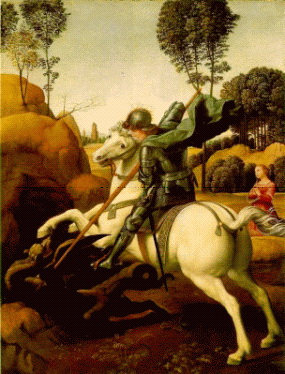
‘Saint George fighting the Dragon’, is a theme approached by very many painters; observing the painting we see the three characters in the centre of the scene – Saint George, the horse and the dragon, and in the background a princess praying. From all the characters only one looks towards the spectator, and this one is the horse, that the painter represented a little anthropomorphized. Looking in his eyes he transmits us the message that the same battle must be taken inside us, to fight this terrible battle that the saint exemplifies in order to obtain that wonderful thing about which we’ve talked in the previous lines, that is to say...Freedom.. We have to understand that, this frightening beast that holds us prisoners is not outside us, but inside us. All those flaws, sins, egos, psychological aggregates studied by all the cultures of the world, compose this symbolical dragon with which Saint George is fighting in order to save that princess, that is to say the soul, our consciousness, that immortal, divine thing inside us. We must become some searchers in our own psychology and through the wonderful sense of auto observation we will realize what needs to be eliminated, corrected or supported. If we want to understand the exterior circumstances through which we pass, the sufferings that we consider unfair, we must know ourselves better. Who are we?...it’s in vain to have everything if we are a mystery for ourselves... 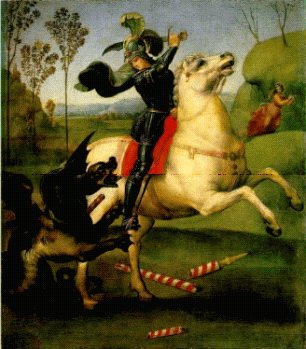
Looking at these pictures, we realize that Raphael teaches us something wonderful: serenity; we observe the serenity, the light on the fighters’ face even though the fight is terrible. Reflecting we will understand that ‘only the light of the consciousness, aimed towards ourselves, not without limits, but fully, centrally, can put an end to contrasts, to the psychological contradictions and to establish in us the real interior balance. If we dissolve all that aggregate of egos, imperfections that we carry inside us, this will generate the awakening of the consciousness or corollary, the true balance of our own mind. The light of the consciousness, giving us a true psychological balance, comes to set every thing at its place and, what was getting in an intimate conflict with us before, actually remains at the right spot.’ Following our journey’s course, we get to a very known and used theme during the renaissance and not only. 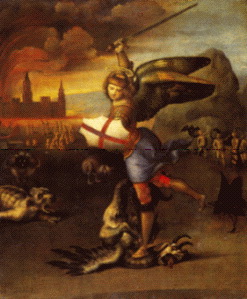
It is the painting ‘Saint Michael fighting the dragon’, painted in the same period with the two paintings representing Saint George. ‘Like Michael defeated the Rebellious Angels, following his example each one of us must defeat and disintegrate all those ego-devils or Psychical aggregates that personify our errors’. ‘The Satan that we carry inside is formed of atoms of the secret enemy. Satan had a beginning; Satan has an end. We need to dissolve Satan to return to the interior Star that always smiled at us. This is the real Final Liberation. Only by dissolving the Ego we get the Absolute Liberation... We need a terrible Revolution of the Consciousness in order to succeed the return to the interior Star that guides our Being. When we dissolve the Ego there is a Total Revolution. The Great divine Reality is happiness, peace, abundance and perfection. The Great Reality cannot create pain. What is perfect cannot create pain. What is perfect still conceives only happiness. The pain was created by the Ego (Satan). It is necessary to dissolve the Ego. Only by dissolving the Ego ignorance and mistake disappear. When the Ego disappears the only thing that remains inside us is what is called love. When the Ego is dissolved the authentic and legitimate happiness comes to us.’ 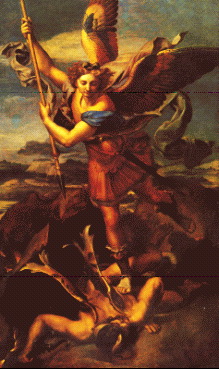
Happiness, twin sister of freedom… putting an end to the blasphemies of that executioner that holds us prisoners inside us and doesn’t let us enjoy the light of the blessed stars, the harmony of this universe… well then ‘appears that something that doesn’t hold about time, that something that is beyond the body, the affects and the mind, that something that is truly unknown to the understanding and that is called: HAPPINESS! In this work she appears as a fighting character, a saint, and she has a pretty interesting weapon: a fine bird feather. In iconography we know that this symbol is next to Saint Catherine. If we look at the saint’s face like the other faces in the pictures we will notice that they look in another way like in another world, some would say she dreams but they rather have a detached attitude, the external situation in which they find themselves doesn’t disturb their interior. They are overwhelmed by the calm, the serenity, the interior balance of these fighting masters, their power to detach and to be above the enemy. Because the beasts of hatred and anger or any other beast cannot be defeated with anger, it would be absurd… the calm and the interior serenity are the real weapons with which we must fight. 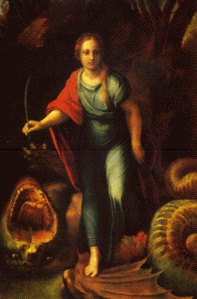
It is absolutely necessary to auto observe us in a sincere way and to find out who we really are. Slowly, slowly without letting ourselves defeated, let’s search in our own psychology and let’s discover what we have in addition and what we don’t have. Let’s not commit the error of hiding us behind the others’ errors or to consider that we know ourselves, and then to rush ourselves after material gains. Material things are like the dust scattered by the wind of eternity... It would be really sad for the ones around us to know us more than we know ourselves... The fragments were extracted from the books written by the Venerable Master Samael Aun Weor 
Comments (0)
 Write comment
|
|||
| < Tribute to the memory and work of the great Chilean astronomer CARLOS MUÑOZ FERRADA | Raphael Sanzio, serene and quiet spirit, part 2 > |
|---|
| Science |
| Art |
| Philosophy |
| Mysticism/Religion |
| Barbelo: Gnosis Magazine |